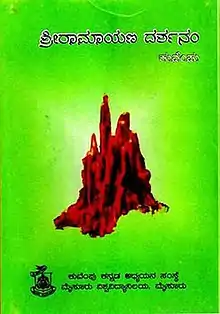Sri Ramayana Darshanam
Sri Ramayana Darshana (ಶ್ರೀ ರಾಮಾಯಣ ದರ್ಶನ) is the most popular work and the magnum opus by Kuvempu in Kannada based on the Hindu epic Ramayana. It earned him many distinctions including the Sahitya Akademi Award and the Jnanapeeth award in 1967.[1][2]
 Cover of third edition (2011) | |
| Author | Kuvempu |
|---|---|
| Country | India |
| Language | Kannada |
| Published | 2011 |
| Publisher | University Of Mysore |
| Media type | Print (Hardcover) |
| Awards | Jnanpith Award (1967) |
| ISBN | 9788126017287 |
Theme
The theme is the well known story of Rama in Valmiki's Ramayana, transfigured in the poet's vision. The poet calls 'darshanam', it is the poet's realization that all the creation is caused, pervaded, sustained and governed by the cosmic mind. Abounding in metaphors and Homeric similes, introduced by the poet himself for the first time in Kannada, the epic brings home the truth that all beings, even the most wicked and sinful, are destined to evolve and ultimately attain perfection.
Modifications to the story
Rama was born to Kaushalya and Dasharatha in Ayodhya, the ruler of the Kingdom of Kosala. His siblings included Lakshmana, Bharata, and Shatrughna. He married Sita. Though born in a royal family, their life is described in the Hindu texts as one challenged by unexpected changes such as an exile into impoverished and difficult circumstances, ethical questions and moral dilemmas. Of all their travails, the most notable is the kidnapping of Sita by demon-king Ravana, followed by the determined and epic efforts of Rama and Lakshmana to gain her freedom and destroy the evil Ravana against great odds. The entire life story of Rama, Sita and their companions allegorically discusses duties, rights and social responsibilities of an individual. It illustrates dharma and dharmic living through model characters.
The fire-ordeal episode
The 'Agni-pravesha' (The fire-ordeal) episode illustrates the above statement. At Sita's command, Lakshmana makes a pyre for her and Sita mounts it. It is at this point that Kuvempu makes a startling deviation from Valmiki. The moment Sita has offered herself as supreme oblation to Agni, Rama too rushes after her, and enters the blazing flames, much to the shock of all earthly spectators. In a moment, however, Rama comes out of the fire holding Sita's palm in his right hand, and the spectators get a glimpse of their divinity. By this sensational innovation Kuvempu has proclaimed the great principle of the supremacy of the law, and the equality of all before the law, not excepting the law-giver himself. What is more, if this 'Agni-pravesha' is intended to reveal to all the world the truth of Sita's chastity, it is also intended to reveal Rama's fidelity and love for Sita.
About the epic
It is a single integral, ecstatic symphony in 22284 lines, running into 877 pages in print. The poet was 32 when he began and 41 when he completed this epic. Every line is chiseled to attain an incremental harmony, hardly to be met with in his lyrics. It converts every situation into a wonderful aural structure which perfectly echoes the germ motif. It is not a series of cantata but a single orchestral piece. Every line is a variation of the relevant thematic rhythm. [3] Sri Ramayana Darshanam is dedicated with deep reverence and respect to his mentor Sri TS Venkannaiah (the first Kannada professor in Karnataka (Mysore University).
See also
- Kanuru Heggaditi and Malegalalli madumagalu, two novels written by Kuvempu
- Kannada literature
- Kannada poetry
- Rashtrakavi (meaning: National poet), a list of poets with the title
References
- Phadnis, Vivek (29 December 2019). "Celebrating Kuvempu's 115th birth anniversary". Deccan Herald. Retrieved 21 April 2020.
- "Shadow On The Glen". Outlook. Retrieved 10 December 2016.
- "Channels". Deccan Chronicle. Retrieved 1 February 2012.
External links
- The Encyclopaedia of Indian Literature (Volume Five (Sasay To Zorgot), Volume 5 By Mohan Lal
- Ramayana Darshanam Review
.jpg.webp)